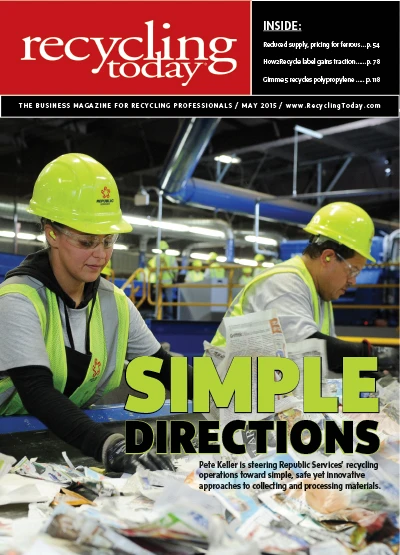 Food waste in the U.S. is an epidemic problem, any way you slice it. It is a problem on many different levels: societally, environmentally and economically. Let’s take a look at each individually first.
Food waste in the U.S. is an epidemic problem, any way you slice it. It is a problem on many different levels: societally, environmentally and economically. Let’s take a look at each individually first.
Resource efficiency
The U.S. Environmental Protection Agency (EPA) estimates at www.epa.gov/foodrecovery that 40 percent of the food produced in the U.S. is never eaten—wasted at the time of production or packaging, during transportation, at retail or restaurants or thrown away by consumers after purchasing it. Similarly, the U.S. Department of Agriculture Economic Research Service estimates at www.usda.gov/oce/foodwaste/faqs.htm that 31 percent, or 133 billion pounds, of available food supply at the retail and consumer levels went unconsumed in 2010.
Food production requires various resources and, when food is not consumed as intended, the result is food and sustenance waste. The societal impact on food not making it from the farm to the consumer is huge, especially given the food insecure population in every town in America. According to Feeding America, a nationwide nonprofit organization of food banks:
- In 2013, 49.1 million Americans, including 33.3 million adults and 15.8 million children, lived in food insecure households.
- It is estimated that 141 trillion calories—that’s 1,249 calories per person, per day—are associated with waste food. That is the daily average caloric need for an adult woman.
When that much food is being wasted and that many people are going hungry each day, there is a problem at a social level.
Environmentally
According to the EPA, the U.S. produced more than 250 million tons of municipal solid waste in 2011, with compostable (food waste, paper and yard waste) material representing 56 percent of this tonnage.
When organics decompose in landfills, they emit methane, a greenhouse gas that is 25 percent more potent than carbon dioxide, according to EPA.
As for total methane emissions in the U.S., landfills account for 18 percent, behind natural gas, petroleum systems and enteric fermentation.
Further, U.S. landfills take up valuable land, and food waste only exacerbates a growing problem. The number of landfills has declined by about 75 percent in the past 25 years. Additionally, mega landfills require waste to travel longer distances, increasing the associated carbon emissions. In addition, landfill capacity varies by state; for example, Arkansas reported more than 600 years’ capacity, while Massachusetts and Rhode Island only have about 12 years’ capacity remaining.
Economically
Food waste, according the National Resource Defense Council, costs the U.S. an estimated $165 billion in retail value yearly.
These estimated financial losses simply account for the food. Add in the costs for transporting and disposing of food waste in a municipal landfill, and the financial losses are even higher.
Finding means to minimize the amount of material sent to landfill is, therefore, a good business decision.
Is regulation catching up?
Cities and municipal governments are taking notice and beginning to implement strategies to combat food waste. In some cases, governments have enacted mandates. In other cases, governments are opting for a milder approach, such as voluntary programs. In the U.S. today, there are about 1,000 government organics curbside programs and 1,179 commercial curbside programs.
On the state level, Oregon has enacted bans that set up organics collection programs; Massachusetts has implemented a commercial organics waste landfill ban; and Rhode Island and Mississippi are considering following suit.
At the city level, San Francisco and Seattle have enacted strict bans and subsequent programs, as has New York City. Austin, Texas; Phoenix; and San Antonio also are considering pilot programs.
According to Ron Gonen, New York City’s former deputy commissioner for recycling and sustainability who now heads up the Closed Loop Fund, “We spend over $85 million a year sending food waste to landfills, so there’s a major cost.”
As more city and municipal governments implement food waste recycling programs and collect program data, the U.S. will begin to get a clearer picture as to the success of its collective programs.
Diverting food waste – A primer
Ask any industry expert, and he or she will tell you that best practice for diverting food waste is to follow the EPA’s Food Recovery Hierarchy pyramid:
- source reduction – Reduce the volume of surplus food generated.
- feed hungry people – Donate extra food to food banks, soup kitchens and shelters.
- feed animals – Divert food scraps to animal feed.
- industrial uses – Provide waste oils for rendering and fuel conversion and food scraps for digestion to recover energy.
- composting – Create a nutrient-rich soil amendment.
- landfill/incineration – This is the last resort to disposal.
We found that some generators are more suited for donation than others. Grocery stores handle a large selection of packaged goods that favors donation, while food manufacturing plants have operations ideally suited for feeding animals. A food waste diversion program that is tailored to feeding animals will be more cost-effective but more difficult to implement than a program that sends food scraps to local composters as the list of acceptable material is more limited. In addition, one could argue that compost represents a higher beneficial value than industrial use as the nutrient-rich material helps prevent soil erosion, dramatically reduces the amount of water required to grow food and presents a powerful alternative to chemical-based fertilizers.
Building infrastructure
In the not-too-recent past, one of the setbacks to addressing food waste at a national level was lack of commercial infrastructure. However, as awareness has increased about food waste, landfill space continues to shrink, and disposal costs continue to rise, the commercial food waste recycling industry has grown.
For example, Quest Resource Management Group, Frisco, Texas, manages more than 500 food waste recycling outlets across the U.S. This program include a combination of composters, animal feed outlets and anaerobic digesters located all over the country. The program feeds safe, fresh food scraps to animals, such as pigs or cows. Additional program components include the conversion of fat, oil and grease into industrial raw materials or biofuel; turning yard debris, dairy and produce into nutrient-rich compost; using anaerobic digestion to turn food waste into soil amendment and renewable energy.
Quest works with more than 10,000 grocery stores and restaurants across the U.S. to recycle more than 500,000 tons of food scraps annually.
Food waste by industry
The Food Waste Reduction Alliance, Washington, recently published a study, available at www.foodwastealliance.org/wp-content/uploads/2014/11/FWRA_BSR_Tier3_FINAL.pdf, analyzing waste reduction effectiveness across different sectors. Among the study’s findings:
- manufacturing – This sector recycled 94.9 percent of all food waste it produced. The number is driven by the sector’s high volume of high-quality food, combined with the ability to contain the material and economies of scale, drive the ability to recycle at such a high level. The food is recycled as animal feed for the most part. Liability concerns prevent the manufacturers from donating the food.
- grocery stores – Only 42.3 percent of the food waste produced by grocery stores is recycled. One-third is donated and two-thirds is recycled as animal feed or compost. A large supply of packaged goods makes it harder to recycle as most recyclers require the material to be repackaged.
- restaurants – Only 15.7 percent of the food waste generated by restaurants is recycled. This franchise-heavy industry makes adoption of new programs more difficult. Additionally, they deal with postconsumer waste, which is more difficult to recycle since it can only go to compost or anaerobic digestion.
U.S. consumers demand large displays of perfect, unblemished produce, which drive retailers to purchase large quantities of fruits and vegetables, constantly rotate their displays and sift through the aisles to remove any trace of imperfection. As a result, retailers generate massive amounts of food waste.
Another factor contributing to the volume of food waste generated is the confusion between “sell by” and “best by” dates. Retailers prematurely remove products from the shelves, further contributing to the amount of food waste generated.
Until U.S. consumers accept that a portion of the fruits and vegetables they purchase are less than perfect, the volume of food waste channeled to food donation or recycling programs will not change.
Technology meets an age-old problem
Several encouraging trends using technology are emerging, each aimed at getting a better handle on tracking and streamlining food waste recycling. In one example, Quest mines millions of rows of data to identify business intelligence to help its clients make better purchasing decisions.
Consumer apps such as Leloca, Gojee and PareUp let consumers reduce food waste while building relationships within their community.
PareUp “aims to prevent food waste by letting its users connect with restaurants and grocery stores to buy their excess product before it’s thrown away,” according to OZY at www.ozy.com/good-sht/the-app-to-stop-food-waste/32711.
Leloca helps consumers minimize restaurant waste by offering flash-sale-type deals. When a table is open at a restaurant, Leloca posts that information along with a reduced-cost dining experience, ensuring that food will not be wasted.
At the manufacturing level, manufacturers are with some degree of success implementing better, more efficient packaging and transportation options.
Based on statistics, it is safe to state that no one will deny that food waste is an epidemic problem—one that carries with it resource efficiency, environmental and economic ramifications. It will take a concerted effort by consumers, retailers and city and state municipalities to tackle organics waste in the U.S. as each plays a pivotal role. With the amount of food waste—both in volume and monetarily—tremendous growth opportunities exist for those willing to step up to the plate.
Brian S. Dick is CEO of Frisco, Texas-based Quest Resource Holding Corp., www.qrhc.com. He took predecessor firm, Quest Resource Management Group, from a startup in 2007 to an enterprise with more than $130 million in revenue in less than six years.
Get curated news on YOUR industry.
Enter your email to receive our newsletters.

Explore the May 2015 Issue
Check out more from this issue and find your next story to read.
Latest from Recycling Today
- Recycled steel price crosses $500 per ton threshold
- Smithers report looks at PCR plastic’s near-term prospects
- Plastics association quantifies US-EU trade dispute impacts
- Nucor expects slimmer profits in early 2025
- CP Group announces new senior vice president
- APR publishes Design Guide in French
- AmSty recorded first sales of PolyRenew Styrene in 2024
- PRE says EU’s plastic recycling industry at a breaking point





